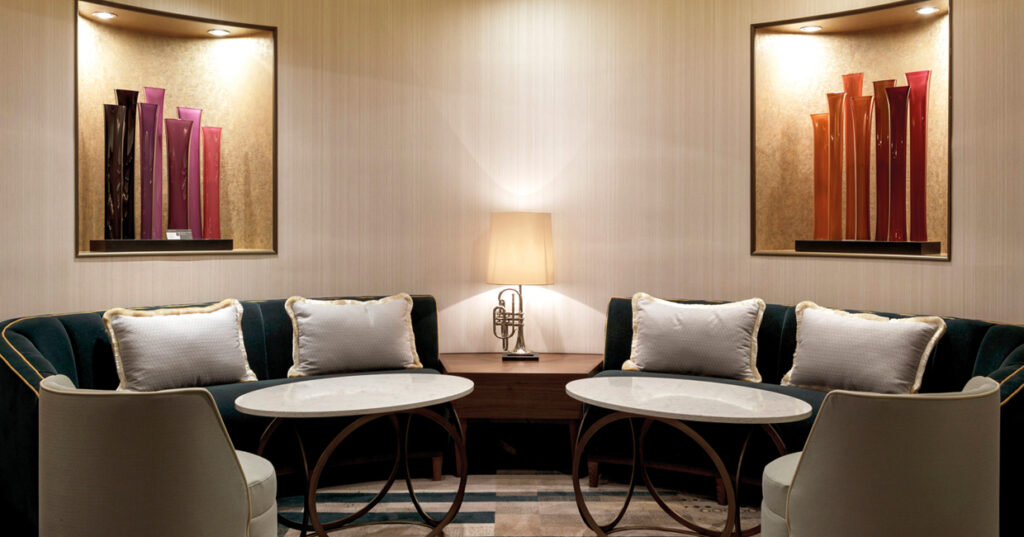How did you come to be involved in the P&O Arcadia & Oceana projects?
We were approached by P&O to look at the refurbishment of these two ships in 2017. The fact that we are primarily hotel designers, but with some cruise experience, was something that attracted them to RPW Design.
The brief was to give the ships a refurb of the cabins, suites and public areas with all the same level of luxury and creative vision to deliver inviting, comfortable yet operational spaces, that have all the qualities of a high-end hotel, but with the practicalities required for a cruise ship.
Could you give us a feel for the character and standout design elements of each ship?
Oceana has wide open decks and guests can walk around the whole ship, something that makes this ship special in relation to others in their fleet. As Oceana was getting a revised destination plan, visiting new locations in the Mediterranean and Arabian Gulf, particular attention was paid to enhance the outdoor decks.
RPW brought a vibrant and fresh vision for the refit of Oceana to delight loyal Oceana guests while also inspiring a new generation of guests.
In contrast to Oceana, Arcadia is an adults-only cruise ship. With a different type of clientele in mind, RPW Design’s objective was to enhance the existing luxurious and more traditional qualities whilst highlighting the sense of travel and adventure.
“Travellers are passionate and loyal to the ships that they like – something that we don’t see in the hotel side of the hospitality industry”
Locality is often such a key starting point for hotel design – what was your starting point for these projects, which by their very nature are nomadic?
It was essential to develop our design solution that focused on creating spaces with which the guests could interact with throughout their journeys around the world and be surrounded by subtle references to nautical exploration.
For example, the bespoke wallpaper we designed for Arcadia’s atrium features all the ship’s destinations overlaid on to a world map in diverse ways.
Culd you talk about how your own experiences on the ships, and interactions with guests informed the new interior schemes?
Guests have a strong affiliation with the ships. Keen cruise goers are drawn to their favourite ships and know and speak about them like an old friend. Travellers are passionate and loyal to the ships that they like – something that we don’t see in the hotel side of the hospitality industry.
We therefore started by getting direct intel from the guests to understand what they felt was missing. Every time we went on board we got more of a feel for Arcadia and Oceana’s DNA. Importantly, being on board during a cruise lets you feel the mood and the buzz of what’s happening operationally and how the guests interact with the spaces.
“RPW brought a vibrant and fresh vision for the refit of Oceana to delight loyal Oceana guests while also inspiring a new generation of guests”
I’m sure a great deal of your experience in high-end hospitality design was transferable to this project, but do you feel there are aspects of cruise ship design that could inform our approach to hotel design in return?
Having worked on a number of fast-paced cruise projects, it has taught us that through being very focused, you are able to achieve tight deadlines whilst still achieving a quality of design by creating spaces with simple yet well detailed elements.
It has also reminded us that when designing, sometimes you have to consider where the building works are taking place, work to the skills and time frame of the client and contractor to ensure that a project is delivered in time and on budget.
What would you say are the key challenges that are unique to cruise ship design?
The main difference being that ships, unlike hotels, move constantly. This brings a whole new level of technical issues that need to be considered. Plus, there are logistical challenges as the ships are never in the same place, which makes site visits and planning more complicated.
There are also a whole different set of regulations that need to be met, which means using a different mind-set when detailing and using a different library of material selections to meet the fire regulations, vibration and weight restrictions.
“Being on board during a cruise lets you feel the mood and the buzz of what’s happening operationally and how the guests interact with the spaces”
What aspects of the projects did you find most rewarding?
Unlike hotel refurbishment where programmes can slip, the fact that most ship refurbs are scheduled with very tight dock times and sail dates are set in stone, means all teams have to be focused on the job in hand. This also brings a sense of achievement where we have to overcome technical challenges and see the designs come to life is a very short space of time.
What do you feel the future has in store for cruise ship design?
Cruising is an expanding industry attracting younger clients, and with it ship design is becoming more sophisticated. Guests are becoming more travel and technologically savvy and have the exposure to high end designs from the hotel industry. Cruise operators need to keep up to date with the demands of these new generations of clients.



